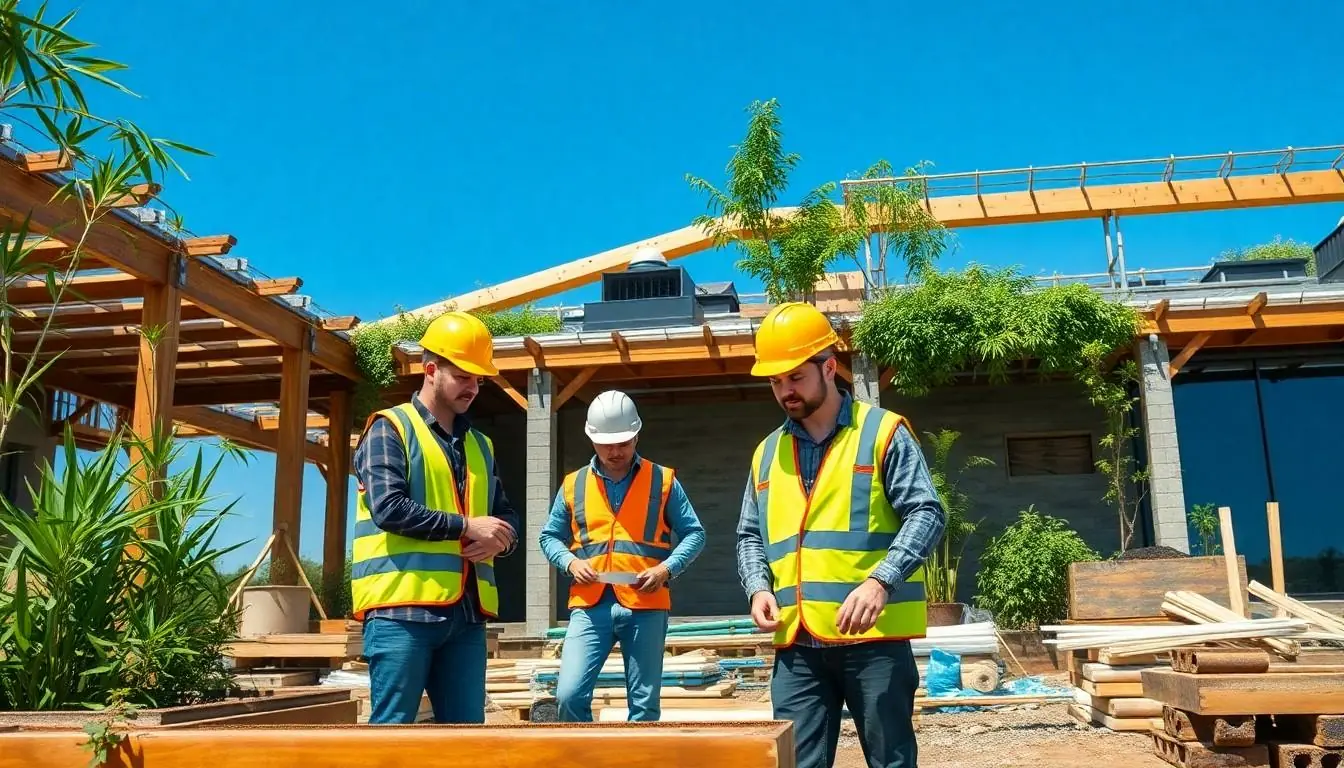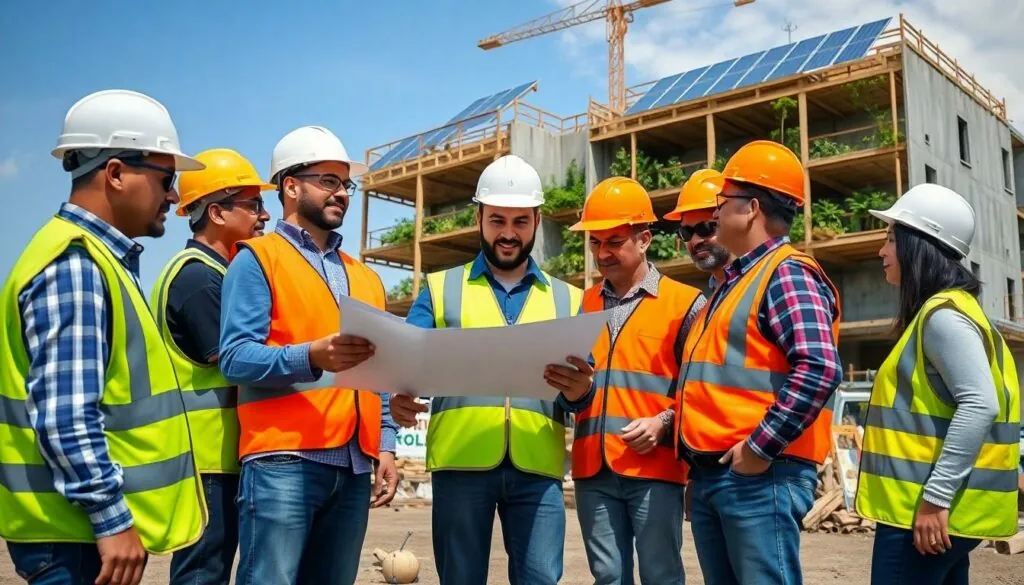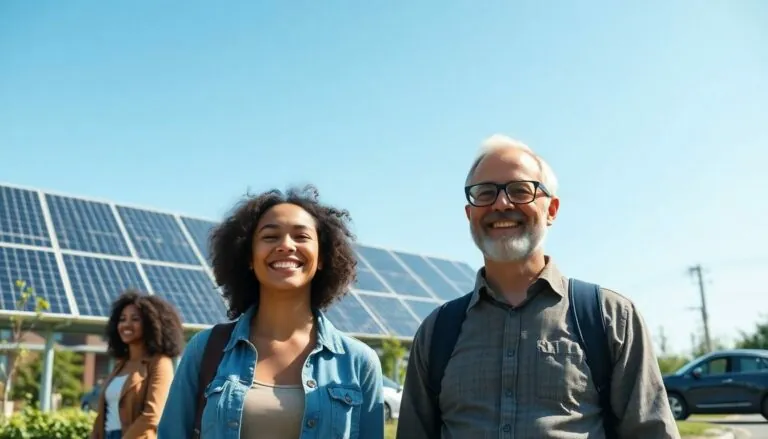In a world where Mother Nature’s throwing shade at unsustainable practices, sustainable construction technology emerges as the superhero we didn’t know we needed. Imagine building homes that not only stand tall but also hug trees and whisper sweet nothings to the environment. It’s not just a trend; it’s a revolution that’s reshaping skylines and saving the planet one eco-friendly brick at a time.
Table of Contents
ToggleOverview of Sustainable Construction Technology
Sustainable construction technology encompasses methods and materials that minimize environmental impact while promoting energy efficiency. This approach addresses the urgent need for accountability regarding resource management in the building industry. The technology integrates renewable energy sources, like solar panels and wind turbines, into designs to reduce reliance on fossil fuels.
Innovative materials such as recycled steel, bamboo, and rammed earth contribute to lower carbon footprints. Green roofs and living walls help enhance biodiversity while improving building insulation. Water conservation techniques, including rainwater harvesting systems and greywater recycling, further promote sustainability in construction.
Industry professionals focus on lifecycle assessments to evaluate the environmental impact of buildings from inception through demolition. Predicted energy savings from these technologies can reach up to 30%, significantly lowering operating costs. Building Information Modeling (BIM) allows for better planning and resource usage, streamlining the construction process for efficiency.
Certifications like LEED (Leadership in Energy and Environmental Design) provide benchmarks for sustainable practices, encouraging compliance with environmentally friendly standards. By adopting these technologies, many construction firms demonstrate commitment to ethical practices while meeting modern consumer demand for eco-conscious homes.
Sustainable construction technology represents a paradigm shift towards more responsible building practices. Innovative advancements continuously reshape the industry, fostering a culture focused on ecological balance and resource optimization. Transitioning to this technology not only benefits the environment but also enhances the quality of living spaces for future generations.
Benefits of Sustainable Construction Technology

Sustainable construction technology offers significant advantages for the environment and economy. By adopting these practices, stakeholders actively contribute to a healthier planet while realizing financial benefits.
Environmental Impact
Innovative building methods notably reduce the carbon footprint of construction projects. This technology promotes energy efficiency, often leading to a decrease in greenhouse gas emissions. Eco-friendly materials such as recycled steel and bamboo minimize resource depletion while supporting biodiversity. Incorporating features like green roofs enhances insulation and fosters urban wildlife habitats. Water conservation techniques, including rainwater harvesting and greywater recycling, address pressing water scarcity issues. Lifecycle assessments help track environmental impacts from design to demolition, ensuring accountability in resource management.
Economic Advantages
Investing in sustainable construction technology often leads to lower operating costs. Industry experts estimate energy savings from these practices can reach 30%. Such reductions improve profit margins for construction firms. Using Building Information Modeling (BIM) optimizes the planning process, streamlining resource allocation. Many projects qualify for certifications like LEED, enhancing their marketability and attracting eco-conscious consumers. Sustainable buildings frequently appreciate faster, driven by increasing demand for environmentally responsible living spaces. By prioritizing sustainability, firms position themselves favorably in a competitive marketplace.
Key Innovations in Sustainable Construction Technology
Sustainable construction technology boasts several key innovations that reshape building practices. These advancements not only benefit the environment but also enhance the efficiency of modern construction.
Renewable Materials
Recycled materials play a vital role in sustainable construction. Products like recycled steel and reclaimed wood reduce waste and minimize the need for virgin resources. Bamboo stands out as a strong alternative due to its rapid growth and renewability. Rammed earth offers thermal mass benefits, creating energy-efficient structures while utilizing locally sourced materials. The integration of these renewable resources significantly lowers carbon footprints associated with construction projects.
Energy Efficiency Solutions
Energy efficiency solutions remain at the forefront of sustainable construction technology. Solar panels generate clean energy, while wind turbines complement renewable energy strategies. Smart building systems optimize resource usage, regulating lighting and heating based on occupancy. Advanced insulation materials reduce energy loss, creating comfortable living environments. Water conservation methods, including rainwater harvesting and greywater recycling, further enhance sustainability while reducing operational costs. Effective implementation of these energy-efficient solutions leads to substantial long-term savings and a reduced environmental impact.
Challenges and Constraints
Sustainable construction technology faces several challenges that can hinder its widespread adoption. Cost considerations and regulatory barriers significantly impact its implementation across various projects.
Cost Implications
High initial costs often deter stakeholders from investing in sustainable technologies. Construction firms encounter expenses associated with renewable materials and innovative building systems, which may exceed conventional options. Sustainability-focused designs, while ultimately cost-effective due to energy savings, require substantial upfront capital. Investing in green materials such as reclaimed wood or recycled steel may present budgetary constraints. Statistics indicate that energy-efficient buildings can save up to 30% on operating costs over time. Awareness of these long-term savings can help justify initial expenditures, but many remain hesitant to commit without immediate financial incentives.
Regulatory Barriers
Regulatory frameworks pose additional obstacles for implementing sustainable construction practices. Building codes and zoning regulations may not accommodate innovative sustainable technologies, creating confusion and delays. Compliance with outdated standards can complicate project timelines and increase costs. Local regulations regarding energy efficiency or material use often vary significantly across regions, leading to inconsistencies in project execution. It’s important for policymakers to understand the benefits of sustainable practices and adjust regulations accordingly. Addressing these regulatory hurdles can facilitate greater adoption of sustainability in the construction industry, promoting both environmental and economic advantages.
Future Trends in Sustainable Construction Technology
Integration of smart technology continues to revolutionize sustainable construction. This trend enhances resource efficiency and boosts energy management in real time. Smart sensors and automated systems optimize energy consumption, significantly lowering operational costs.
Utilization of prefabrication methods is on the rise. These methods allow builders to assemble structures more efficiently, minimizing waste and reducing construction time compared to traditional practices. Prefabricated components reduce the carbon footprint of building sites, promoting sustainable methods.
The adoption of advanced materials contributes to sustainability. Biodegradable composites and self-healing concrete are gaining traction, providing both durability and environmental benefits. These innovations address long-term maintenance and reduce resource consumption over a building’s lifecycle.
Incorporation of vertical gardens and green roofs is becoming mainstream. These features enhance urban environments, increase insulation, and improve air quality. Biodiversity fosters healthier ecosystems in urban settings, benefiting both residents and wildlife.
Collaboration among industry stakeholders enhances sustainable construction practices. Architects, builders, and environmental engineers are increasingly adopting holistic approaches that balance economic, social, and ecological considerations. This teamwork fosters innovation and streamlines project execution.
Governments are progressively establishing incentives to encourage sustainable building practices. Financial subsidies and tax incentives for eco-friendly developments appeal to investors and developers. More stakeholders are choosing to invest in sustainable construction technologies due to potential cost savings.
Virtual reality and augmented reality are transforming project design and planning. These technologies allow stakeholders to visualize projects before construction, reducing errors and optimizing designs for sustainability. Accurate visualizations enhance collaboration and decision-making processes.
Demand for sustainable urban planning continues to rise. Communities are focusing on integrating transportation, housing, and green spaces, promoting walkability and reducing dependence on fossil fuels. Sustainable designs create more livable environments for future generations.
Sustainable construction technology is paving the way for a more responsible and eco-friendly building industry. By embracing innovative materials and energy-efficient practices, stakeholders are not only addressing environmental challenges but also unlocking economic benefits. The movement towards sustainability is gaining momentum and reshaping urban landscapes for future generations.
As advancements continue to emerge, the integration of smart technologies and innovative building methods will further enhance resource efficiency. Overcoming initial cost barriers and regulatory challenges will be essential for widespread adoption. The commitment to sustainable practices is not just a trend; it’s a vital step toward creating a healthier planet and improving living conditions. The future of construction lies in sustainability, and its impact will resonate for years to come.




